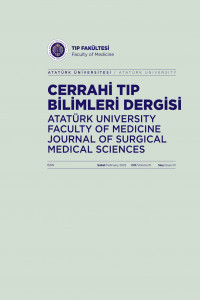SAK sonrası Caudate Nucleus Degenerasyonu
Subaraknoid kanama, kaudate çekirdek, dejenerasyon, komplikasyon
Exploration of Caudate Nucleus Degeneration following Subarachnoid Hemorrhage: An Experimental Study
subarachnoid hemorrhage, caudat nucleus, dejeneration,
___
- 1. Pellizzaro Venti M, Paciaroni M, Caso V. Caudate infarcts and hemorrhages. Front Neurol Neurosci. 2012;30:137–40.
- 2. Teramoto S, Tokugawa J, Nakao Y, Yamamoto T. Caudate haemorrhage caused by pseudoaneurysm of accessory middle cerebral artery. BMJ Case Rep. 2015 Dec;2015.
- 3. Fu C, Jiang P, Zhao Y, Li Y. Recurrent Artery of Heubner Aneurysm Masquerading as Caudate Hemorrhage without Subarachnoid Hemorrhage in Moyamoya Disease: A Case Report and Literature Review. Vol. 18, Current medical imaging. United Arab Emirates; 2022. p. 429–31.
- 4. Fossas P, Barrufet P, Andreu J, Navarro C. [Cerebral amyloid angiopathy and recurrent cerebral hematoma. Clinicopathological study of a case]. Neurologia. 1992 Mar;7(3):109–12.
- 5. Germanwala A V, Huang J, Tamargo RJ. Hydrocephalus after aneurysmal subarachnoid hemorrhage. Neurosurg Clin N Am. 2010 Apr;21(2):263–70.
- 6. Yoshimoto Y, Ochiai C, Kawamata K, Endo M, Nagai M. Aqueductal blood clot as a cause of acute hydrocephalus in subarachnoid hemorrhage. AJNR Am J Neuroradiol. 1996;17(6):1183–6.
- 7. Kanat, Aydin. Asymptomatic familial cerebral aneurysms. Neurosurgery. 1999 Jun;44(6):1364–5.
- 8. Kepoglu U, Kanat A, Aydin MD, Akca N, Kazdal H, Zeynal M, et al. New Histopathologic Evidence for the Parasympathetic Innervation of the Kidney and the Mechanism of Hypertension Following Subarachnoid Hemorrhage. J Craniofac Surg. 2020 Dec;31(3):865–70.
- 9. Celiker M, Kanat A, Aydin MD, Ozdemir D, Aydin N, Yolas C, et al. First emerging objective experimental evidence of hearing impairment following subarachnoid haemorrhage; Felix culpa, phonophobia, and elucidation of the role of trigeminal ganglion. Int J Neurosci. 2019 Jan;129(8):794–800.
- 10. Asakura K, Mizuno M, Yasui N. [Clinical analysis of 24 cases of caudate hemorrhage]. Neurol Med Chir (Tokyo). 1989 Dec;29(12):1107–12.
- 11. Weisberg LA. Caudate hemorrhage. Arch Neurol. 1984 Sep;41(9):971–4.
- 12. Kanat A, Tsianaka E, Gasenzer ER, Drosos E. Some Interesting Points of Competition of X-Ray using during the Greco-Ottoman War in 1897 and Development of Neurosurgical Radiology: A Reminiscence. Turk Neurosurg. 2022;32(5):877–81.
- 13. Aydin MD, Kanat A, Sahin B, Sahin MH, Ergene S, Demirtas R. New Experimental Finding of Dangerous Autonomic Ganglia Changes in Cardiac Injury following Subarachnoid Hemorrhage; A reciprocal culprit-victim relationship between the brain and heart. Int J Neurosci. 2022 Jun;1–15.
- 14. Aydin MD, Kanat A, Turkmenoglu ON, Yolas C, Gundogdu C, Aydin N. Changes in number of water-filled vesicles of choroid plexus in early and late phase of experimental rabbit subarachnoid hemorrhage model; The role of petrous ganglion of glossopharyngeal nerve. Acta Neurochir (Wien). 2014;156(7):1311–7.
- 15. Aydin MD, Kanat A, Yilmaz A, Cakir M, Emet M, Cakir Z, et al. The role of ischemic neurodegeneration of the nodose ganglia on cardiac arrest after subarachnoid hemorrhage: an experimental study. Exp Neurol. 2011 Jul;230(1):90–5.
- 16. Yilmaz A, Aydin MD, Kanat A, Musluman AM, Altas S, Aydin Y, et al. The effect of choroidal artery vasospasm on choroid plexus injury in subarachnoid hemorrhage: experimental study. Turk Neurosurg. 2011;21(4):477–82.
- 17. Kumral E, Evyapan D, Balkir K. Acute caudate vascular lesions. Stroke. 1999 Jan;30(1):100–8.
- 18. Chong Z, Feng Y. Protective effects of dl-3-n-butylphthalide on changes of regional cerebral blood flow and blood-brain barrier damage following experimental subarachnoid hemorrhage. Chin Med J (Engl). 1998 Sep;111(9):858–60
- Başlangıç: 2022
- Yayıncı: Atatürk Üniversitesi
Esra ÇINAR TANRIVERDİ, H. Alper TANRİVERDİ, Ayşe Semra DEMİR AKÇA
Mehmet AYDİN, Mehmet Kürşat KARADAĞ, Mehmet Hakan ŞAHİN, Mete ZEYNAL, Ali AHISKALIOĞLU, Osman Nuri KELEŞ, Sevilay ÖZMEN
ÇOCUKLUK DÖNEMİ CASTLEMAN HASTALIĞI: OLGU SUNUMU
Burçin ERGÜL, Sevilay ÖZMEN, Sare ŞİPAL
Izatullah JALALZAİ, Hakan USTA, Ebubekir SÖNMEZ, İbrahim PİR, Yasin KILIÇ, Ümit ARSLAN, Merve ÇETİN, Bilgehan ERKUT
SAK sonrası Caudate Nucleus Degenerasyonu
Ayhan KANAT, Mehmet Hakan ŞAHİN, Mehmet AYDİN, Osman Nuri KELEŞ
Akciğer Adenokarsinomlarında Patern Analizi ve Derecelendirme
